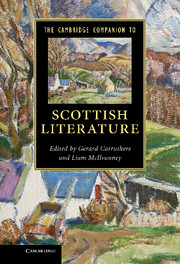Book contents
- Frontmatter
- Contents
- Notes on Contributors
- Acknowledgements
- Chronology
- Introduction
- 1 Scottish Literature before Scottish Literature
- 2 The Medieval Period
- 3 Reformation and Renaissance
- 4 The Aftermath of Union
- 5 Robert Burns
- 6 Enlightenment, Romanticism and the Scottish Canon
- 7 Scott and the Historical Novel
- 8 The Gaelic Tradition
- 9 Scottish Gothic
- 10 Victorian Scottish Literature
- 11 Robert Louis Stevenson
- 12 Hugh MacDiarmid and the Scottish Renaissance
- 13 Popular Fiction
- 14 Muriel Spark
- 15 The Glasgow Novel
- 16 ‘What is the language using us for?’
- 17 The Emergence of Scottish Studies
- 18 Otherworlds
- 19 Scottish Literature in Diaspora
- Index
- References
3 - Reformation and Renaissance
Published online by Cambridge University Press: 05 January 2013
- Frontmatter
- Contents
- Notes on Contributors
- Acknowledgements
- Chronology
- Introduction
- 1 Scottish Literature before Scottish Literature
- 2 The Medieval Period
- 3 Reformation and Renaissance
- 4 The Aftermath of Union
- 5 Robert Burns
- 6 Enlightenment, Romanticism and the Scottish Canon
- 7 Scott and the Historical Novel
- 8 The Gaelic Tradition
- 9 Scottish Gothic
- 10 Victorian Scottish Literature
- 11 Robert Louis Stevenson
- 12 Hugh MacDiarmid and the Scottish Renaissance
- 13 Popular Fiction
- 14 Muriel Spark
- 15 The Glasgow Novel
- 16 ‘What is the language using us for?’
- 17 The Emergence of Scottish Studies
- 18 Otherworlds
- 19 Scottish Literature in Diaspora
- Index
- References
Summary
In a curious twist of cultural history, Scotland enjoys a ‘Renaissance’ that began in the twentieth century rather than at some point between the fourteenth and the sixteenth centuries. Denis Saurat’s term for the cultural energies of the movement associated with Hugh MacDiarmid renders the fate of earlier Scottish literature ‘curiouser’ still: an anomaly in both Scottish and European literary history. Even in the wake of a new ‘British history’ which recognises the separate and interlinked cultures of the four nations, and of renewed sympathy towards the idea of a ‘northern’ Renaissance, the depths of the literature associated, for example, with Mary, Queen of Scots (1542–87), and her son, James (1566–1625) – poets themselves – remain uncharted beyond specialist critical studies. Instead, a story about an impossible, or improbable, first Scottish Renaissance is told, woven out of two historical events, often perceived as culturally calamitous: the mid-sixteenth-century Reformation, and the Union of the Crowns in 1603. Yet Edwin Muir’s powerfully emotive visions of the hollowed-out culture resulting from Scotland’s violent Reformation, for example, should not prevent us from seeing interesting redirections and reconceptualisations of artistic expression rather than its complete extinction.
The very term ‘Renaissance’ is perhaps a distorted looking-glass through which to view artistic and intellectual changes which assume different forms in different cultures. Coined by the French writer Jules Michelet in 1855, then famously used by Jacob Burckhardt in The Civilization [or Culture] of the Renaissance in Italy (1860), it embodied the monumental processes of intellectual, artistic and cultural renewal or rebirth which could collectively be judged a self-conscious or purposeful negation of an earlier medium aevum or ‘middle age’. This idea of Renaissance spawns its own myth (an illuminatory Renaissance versus the medieval ‘dark ages’) but might be preferable to the alternative periodisation of ‘early modern’, which unhelpfully foregrounds the notion of a prescient, welcome ‘modernity’.
- Type
- Chapter
- Information
- The Cambridge Companion to Scottish Literature , pp. 41 - 55Publisher: Cambridge University PressPrint publication year: 2012
References
- 2
- Cited by

